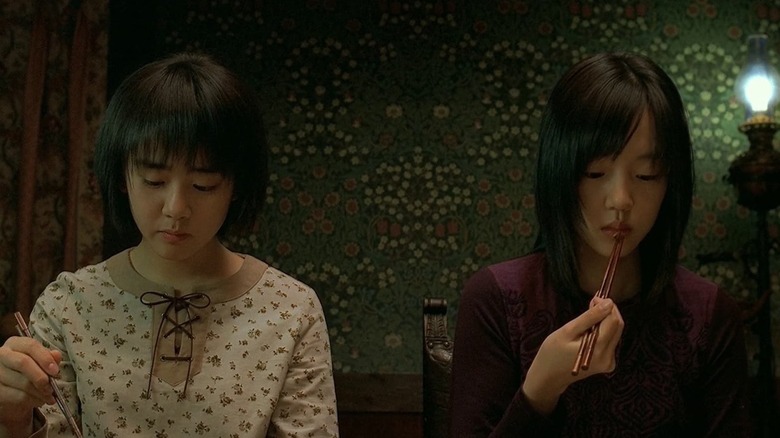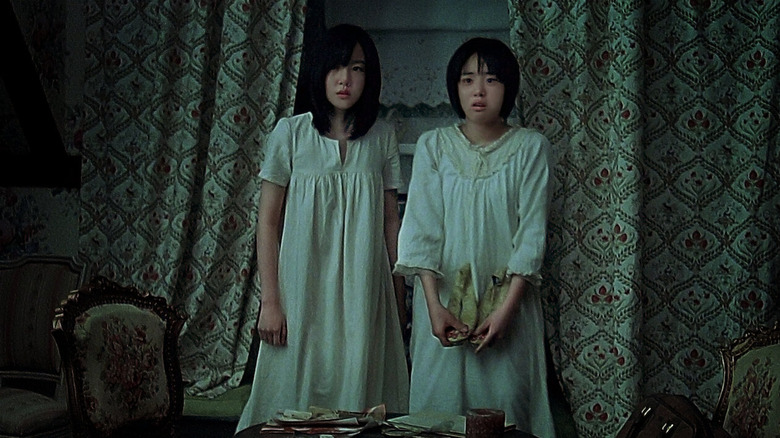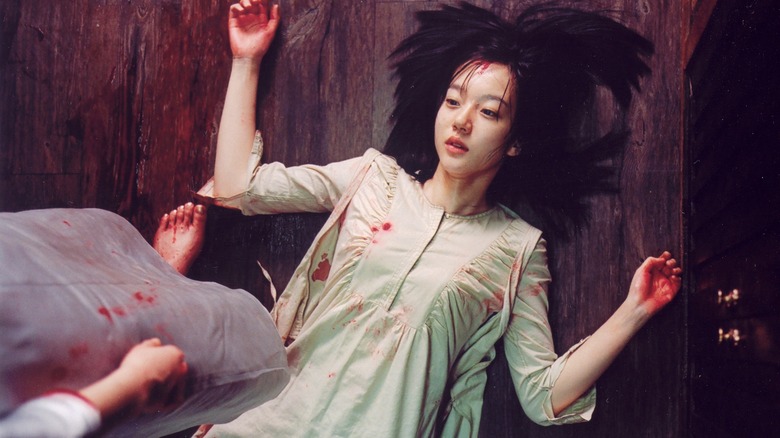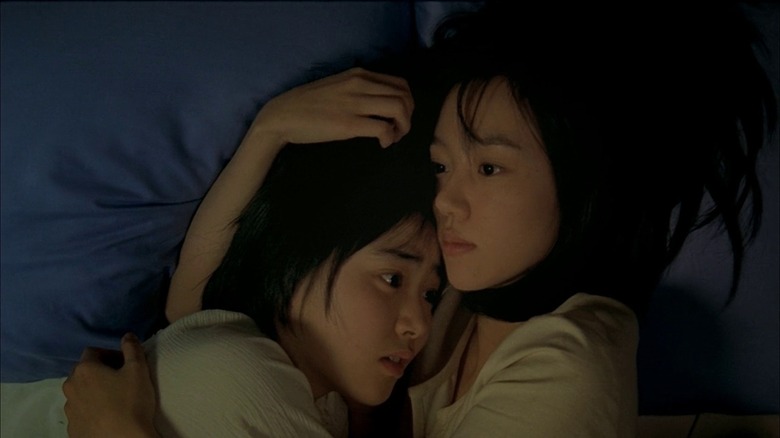A Tale Of Two Sisters Ending Explained: It's All In The Family
We may receive a commission on purchases made from links.
Some of the best genre movies of the past two decades come from Korea. While a lot of people know the names Bong Joon-ho and Park Chan-wook, not as many people are aware of the brilliant but underrated Kim Jee-woon. Director Kim has given us some all-time great Korean horror and genre movies like "I Saw the Devil." He even made the fantastic Apple TV+ series "Dr. Brain."
But before all that, director Kim's made "A Tale of Two Sisters," a horror movie based on a popular Korean folktale (which has been adapted several times). The plot focuses on Su-mi, a young girl recently released from a mental institution. Finally back home, she is very protective of her younger sister Su-yeon, and quite cold toward her stepmother Eun-joo — who used to be a nurse for the sisters' late mother. Su-mi seems plagued by disturbing visions of ghosts plaguing the house, but if Mike Flanagan's work has taught us anything it is that the ghost stories are all about trauma and human horror — and there's plenty of both in here. Here's what happens at the end of "A Tale of Two Sisters" and what it all means.
What you need to remember about the plot of A Tale of Two Sisters
From the get-go, it's clear there's something sinister going on. At first, it seems like it might be ghosts. Su-mi has constant nightmares about the ghost of her mother, and when her aunt comes for dinner one night she sees the ghost of a dead girl as she suffers a seizure.
However, it becomes clear that there's something more human to all of this, with Eun-joon abusing the girls while their dad is completely oblivious to it. Su-yeon gets the worst of it, even getting locked in a wardrobe closet by her stepmother for no reason. When Su-mi finally snaps and confronts her dad about the abuse towards her sister, he reveals Su-yeon is actually dead — despite her standing next to Su-mi. This is the first big twist of the film. All along, Su-mi has been imagining her dead sister.
Ghost or not, there's still the matter of Eun-joo lashing out at the girls — well, girl. The stepmother becomes more erratic, plagued by what she thinks are even more ghosts. After Su-mi sees what she thinks is Eun-joon dragging her sister in a bloody sack, they get into a fight. Eun-joo nearly beats her stepdaughter to death and leaves her unconscious. That's when the second big twist in the movie (there are many!) arrives, as Eun-joo sees her husband arrive — with Eun-joo. This Eun-joo looks healthier than the one we know, and is wearing a suit. She talks to Eun-joo, but refers to her as Su-mi.
That's right. Turns out, Su-mi was not only seeing her dead sister, but she had a split personality and thought she was her own stepmother. The only ghosts were the ones on Su-mi's head.
What happened at the end of A Tale of Two Sisters?
Eventually, the film flashes back to how everything went wrong for the titular two sisters. Throughout the film, we see Su-mi having nightmares and visions about her mom, who died horribly. Turns out, the mother committed suicide in Su-yeon's wardrobe, after her husband started having a not-so-subtle affair with Eun-joo, a nurse meant to take care of the mother. Su-yeon finds her mother, and in an attempt to save her, she accidentally knocks over the wardrobe, which falls on her. Eun-joo discovers her and hesitates to help, but just as she turns back to save Su-yeon, she is stopped by a resentful Su-mi who yells at the woman for taking her mom's place. Eun-joo, in a moment of anger, walks away. She warns Su-mi that she would regret that day, as she leaves Su-yeon to die. It is this incident that pushes Su-mi to have a mental breakdown and split personality
The film ends just as it begins. We see Su-mi in a hospital, with doctors saying that her dissociative incident indicates she is not fit to live outside the hospital. Satisfied, and with no one standing in the way of her place as the only woman in the house, Eun-joo returns to what's now her home. Except that night, a real ghost appears — Su-yeon's. She crawls out of the closet and kills Eun-joo. This frees Su-mi from her pain, as she is seen smiling from the hospital.
What the ending of A Tale of Two Sisters means
"A Tale of Two Sisters" is based on the popular folktale "Janghwa Hongryeon jeon." That folktale takes a more traditional evil stepmother trope, with Eun-joon purposely killing the girls to take over the household and ultimately being defeated by their ghosts. The crux of Kim Jee-woon's adaptation is that it is more about Su-mi's emotional journey and the guilt that breaks her. Speaking to L.A. Review of Books, director Kim said, "Su-mi is brought to destruction because she retains an innocence that makes her think she is the cause of all tragedies, so she's an extremely emotional character."
Eun-joo is as guilty of tearing the family apart in the movie as she is in the folktale, but the film frames it differently. Eun-joo doesn't set out to kill the girls, but she still lets one of them die out of spite. But as director Kim says, what's important is not Eun-joo's choice, but how her words toward Su-mi made her think she was responsible. Of course, she wasn't, but the damage was done the moment Su-mi found her sister and mother dead.
Speaking with Fangoria, director Kim Jee-Woon elaborated further on what it all means. "The film is about memories as well as guilt and hatred," Kim said, adding: "[T]he thing about bad memories is that, when you want to forget about them, they will come up and torture you. They have that power."
How does A Tale of Two Sisters compare to The Uninvited?
The '00s were full of remakes of horror movies, particularly of foreign-language horror movies — from "The Ring" and "The Grudge," to "Shutter" and "One Missed Call." It wasn't a big surprise, then, that "A Tale of Two Sisters" would also get an English-language remake in 2009 with "The Uninvited."
Though both follow the same basic plot, there are differences in the adaptation — particularly the beginning and end. This film opens not with Anna being released from the hospital but with her recalling the night of the accident in which her mother burned to death. Then, the film ends with the reveal that it wasn't Anna that killed her stepmother but rather Anna's sister, Alex — even if the movie makes it clear Anna was more than okay with trying to kill her dad and stepmother in a fit of rage. "The Uninvited" also takes a different approach to the role of the stepmother, here portrayed more clearly as a kind, caring woman, hinting at the twist much earlier.
Finally, the two films take different approaches to the supernatural occurrences. The remake focuses on the one sister that sees strange events and ghosts. Meanwhile, "A Tale of Two Sisters" expands on the supernatural and has several characters experience weird things, as the movie does seem to argue more heavily toward something supernatural.




